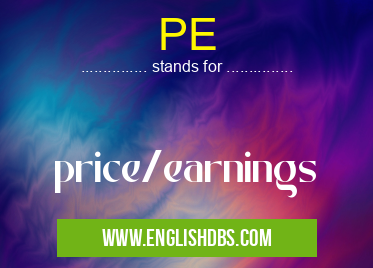What does PE mean in ACCOUNTING
Price to earnings ratio (P/E) is a widely used financial ratio that measures the value of a company relative to its earnings. It helps investors assess whether a company is under or overvalued in the stock market. P/E can be calculated by dividing the current share price of a company with its per-share earnings figure. In simple terms, P/E compares how many times an investor needs to invest in the stock market to earn one rupee of the company's profits.

PE meaning in Accounting in Business
PE mostly used in an acronym Accounting in Category Business that means price/earnings
Shorthand: PE,
Full Form: price/earnings
For more information of "price/earnings", see the section below.
» Business » Accounting
What Is Price To Earnings (P/E) Ratio
The price-to-earnings ratio (P/E) is an important measure that allows investors to compare companies based on their current share prices and their overall profitability. The ratio helps investors determine how much they are willing to pay for each rupee of earnings generated by a company. The higher the P/E, the more expensive it is for investors relative to its earning potential. On the other hand, if stocks have lower PE ratios, it indicates that investors are buying the shares at less cost per rupee earned, making them better long-term investments. This is why it's important for investors to understand how P/Es work and what they mean when assessing stocks.
Essential Questions and Answers on price/earnings in "BUSINESS»ACCOUNTING"
What is P/E?
Price/Earnings (P/E) ratio is a measure used by investors to compare the relative value of a company's stock. The ratio is calculated by dividing the current stock price of the company by its earnings per share (EPS). This allows investors to compare similar stocks from different sectors or industries and make informed investment decisions.
Why use the P/E ratio?
The P/E ratio helps investors decide if a company's stock is undervalued or overvalued relative to other stocks in the same industry. It can indicate either an undervalued security with potential for future appreciation, or an overvalued security with a higher risk of capital loss. Higher P/E ratios may also indicate that investors are expecting strong growth in a specific sector or industry
What factors affect P/E?
The level of investor confidence and market demand, as well as changes in estimated earnings, can all drive changes in the P/E ratio. If earnings estimates decrease compared to price, it would result in an increase in the P/E ratio. Similarly, if earnings estimates increase versus price, this may result in a decrease of the P/E ratio.
How do you calculate Price-to-Earnings Ratio?
To calculate Price-to-Earnings Ratio (P/E), divide the current stock price by its Earnings Per Share (EPS). For example, if a company has an EPS of $2 and its current stock price is $20 then its Price-to-Earnings Ratio would be 10 ($20/$2 = 10).
What does 'high' vs 'low' PE mean?
A ‘high' PE indicates that investors are confident about the current performance of that particular security and expect it to outperform average returns going forward. Conversely, a ‘low' PE might indicate that investors have less confidence on its current performance and future prospects.
Is there an ideal P/E range I should look for when investing?
It depends on what sort of investments you're interested in making; there is no one ideal range that applies across all industries or sectors. However, typically it's considered prudent to look for companies with relatively low P/Es (Range between 4 - 14) relative to their competitors or peers within their respective industries.
What is forward basis and how does it relate to a P/E calculation?
Forward basis refers to estimating expected income instead of using tangible past results when calculating a company's Price-to-Earnings Ratio (P/E). In some cases analysts will use what they believe could be achieved based on expected improvement in earnings such as more relevant product launches or cost saving initiatives promoted internally within the organization.
What does high vs low PE mean for bonds?
Bonds typically have inverse relationships with prices, meaning when bond prices are high their yields decrease; conversely when bond prices are low their yields increase. Therefore when bond prices are high this may imply that yields have decreased thus indicating lower interest rate expectations amongst traders and speculators which could lead us towards conclusions regarding lower inflationary pressures which could subsequently cause bond holders to gravitate towards higher yielding securities at lower prices - resulting in reduced PE Ratios.
Are there any dangers associated with relying too heavily on just looking at PE ratios when making investing decisions?
Yes - relying solely on any single metric such as P/Es can be dangerous as it overlooks important wider aspects such as competitive advantages against peers within same markets / sectors etc., rising costs due to macroeconomic events beyond company control or externalities arising from unforeseen international events outside of domestic economic framework etc.. As with any decision process, multiple metrics should always be taken into consideration before opting for any significant investment move.
Final Words:
In conclusion, price-to-earnings (P/E) ratio is an important financial tool used by investors when comparing companies in order to make wise investment decisions. A high PE implies shares are more expensive relative to their profits while lower PE suggests cheaper stocks with greater long term growth potential. Knowing about this valuation metric and understanding when and why you should use it can help you make informed investment decisions in volatile markets.
PE also stands for: |
|
| All stands for PE |
